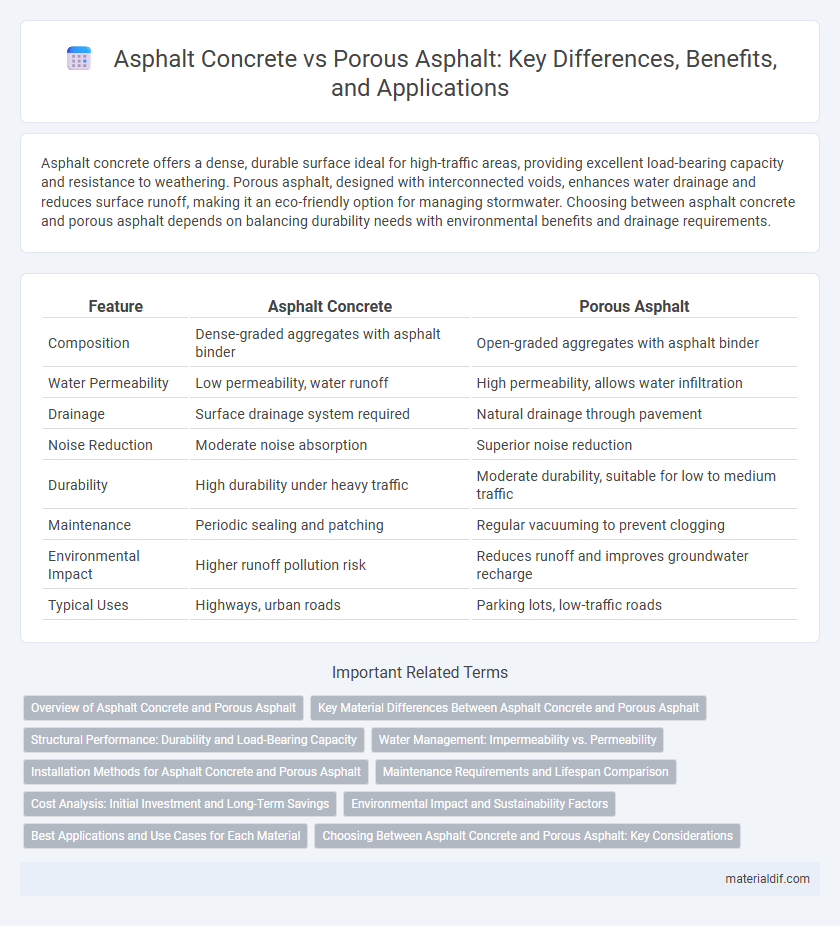Asphalt concrete offers a dense, durable surface ideal for high-traffic areas, providing excellent load-bearing capacity and resistance to weathering. Porous asphalt, designed with interconnected voids, enhances water drainage and reduces surface runoff, making it an eco-friendly option for managing stormwater. Choosing between asphalt concrete and porous asphalt depends on balancing durability needs with environmental benefits and drainage requirements.
Table of Comparison
| Feature | Asphalt Concrete | Porous Asphalt |
|---|---|---|
| Composition | Dense-graded aggregates with asphalt binder | Open-graded aggregates with asphalt binder |
| Water Permeability | Low permeability, water runoff | High permeability, allows water infiltration |
| Drainage | Surface drainage system required | Natural drainage through pavement |
| Noise Reduction | Moderate noise absorption | Superior noise reduction |
| Durability | High durability under heavy traffic | Moderate durability, suitable for low to medium traffic |
| Maintenance | Periodic sealing and patching | Regular vacuuming to prevent clogging |
| Environmental Impact | Higher runoff pollution risk | Reduces runoff and improves groundwater recharge |
| Typical Uses | Highways, urban roads | Parking lots, low-traffic roads |
Overview of Asphalt Concrete and Porous Asphalt
Asphalt concrete is a dense pavement material composed of aggregates bound by asphalt binder, providing high durability and strength for heavy traffic applications. Porous asphalt features interconnected voids that allow water infiltration, enhancing stormwater management and reducing surface runoff. Both materials offer unique benefits, with asphalt concrete prioritizing load-bearing capacity and porous asphalt emphasizing environmental sustainability and permeability.
Key Material Differences Between Asphalt Concrete and Porous Asphalt
Asphalt concrete primarily consists of a dense mixture of aggregates bound by asphalt cement, creating a solid, impermeable surface ideal for heavy traffic and durability. Porous asphalt contains a more open-graded aggregate structure with reduced fine particles, allowing water to drain through the pavement and reduce surface runoff. The key material difference lies in the aggregate gradation and binder content, which directly impacts permeability and load-bearing capacity.
Structural Performance: Durability and Load-Bearing Capacity
Asphalt concrete offers superior structural performance with high durability and excellent load-bearing capacity, making it ideal for heavy traffic and long-term use. Porous asphalt, while effective for stormwater management due to its permeability, generally exhibits lower load-bearing strength and may require more frequent maintenance under heavy loads. Understanding these differences is critical for selecting the appropriate pavement type based on traffic demands and environmental considerations.
Water Management: Impermeability vs. Permeability
Asphalt concrete is designed with impermeability to prevent water infiltration, effectively reducing surface water but potentially causing runoff and flooding issues. Porous asphalt features high permeability, allowing water to drain through the pavement, enhancing stormwater management and reducing surface water accumulation. This permeability improves groundwater recharge and minimizes hydroplaning risks, making porous asphalt a sustainable choice for water management in urban environments.
Installation Methods for Asphalt Concrete and Porous Asphalt
Asphalt concrete installation involves a layered process of placing and compacting hot mix asphalt over a prepared subgrade to create a strong, durable surface, typically requiring heavy rollers and precise temperature control. Porous asphalt installation incorporates a similar layering but emphasizes an open-graded aggregate base that allows water to permeate through the pavement, requiring specialized placement techniques to maintain porosity and prevent clogging during compaction. Proper base preparation, material selection, and compaction methods are critical for both types to ensure longevity and performance under varying environmental conditions.
Maintenance Requirements and Lifespan Comparison
Asphalt concrete requires regular maintenance such as sealing cracks and resurfacing every 10-15 years to extend its lifespan, which typically ranges from 15 to 25 years depending on traffic and climate conditions. Porous asphalt demands more frequent inspections and cleaning to prevent clogging of its drainage pores, with an average lifespan of 10 to 15 years influenced by its permeability and environmental factors. Understanding these maintenance and durability differences is crucial for choosing the appropriate pavement solution for specific infrastructure needs.
Cost Analysis: Initial Investment and Long-Term Savings
Asphalt concrete typically requires a higher initial investment due to material and installation costs compared to porous asphalt, which often involves lower upfront expenses. Porous asphalt contributes to long-term savings by reducing stormwater management costs and minimizing environmental impact through improved drainage. Evaluating the total cost of ownership, porous asphalt can offer economic advantages over time despite its initially modest investment.
Environmental Impact and Sustainability Factors
Asphalt concrete, known for its durability and smooth finish, tends to increase surface runoff and contribute to urban heat island effects, impacting local ecosystems adversely. Porous asphalt, designed with high void content, enhances stormwater infiltration, reducing runoff and improving groundwater recharge, thereby promoting sustainable urban drainage systems. The environmental benefits of porous asphalt include decreased surface temperatures and pollutant filtration, making it a preferred choice for eco-friendly pavement solutions.
Best Applications and Use Cases for Each Material
Asphalt concrete is ideal for highways, parking lots, and heavy-traffic roads due to its strength and durability, providing a smooth, load-bearing surface. Porous asphalt excels in urban areas and parking lots requiring stormwater management by allowing water infiltration, reducing runoff and promoting groundwater recharge. Both materials serve specific needs: asphalt concrete for structural reliability in high-traffic scenarios, and porous asphalt for sustainable drainage in environmentally sensitive locations.
Choosing Between Asphalt Concrete and Porous Asphalt: Key Considerations
Asphalt concrete offers high durability and load-bearing capacity, making it ideal for heavy traffic areas, while porous asphalt enhances stormwater management through superior drainage and reduced runoff. Choosing between asphalt concrete and porous asphalt depends on factors such as traffic volume, environmental regulations, and site-specific hydrological needs. Cost, maintenance requirements, and long-term sustainability goals also play crucial roles in determining the most suitable pavement solution.
Asphalt Concrete vs Porous Asphalt Infographic

 materialdif.com
materialdif.com